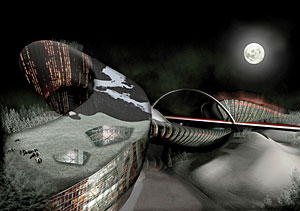RECORD invites designers to redefine the refugee experience.
Despite the best efforts of global capital and the Internet to erase boundaries between countries, citizenship—and its attendant rights—still is defined by geography. The world’s 10 million refugees, then, occupy intermediate places where everything from basic services to a sense of dignity is defined by design. Since these schemes rarely transcend the minimal requisites of survival, we asked three architects to imagine enlightened alternatives to the tent cities and training centers that tend to dot the refugee landscape today, either in the architects’ own neighborhoods or abroad. Each of these participants has earned social-responsibility stripes. Oslo-based firm Code has realized 24 units of transitional housing for homeless Norwegians, which blends elegantly into the capital city’s Moss neighborhood. Melbourne, Australia’s PHOOEY Architects recently completed a playground for child residents of public housing in South Melbourne. And Deborah Gans of New York was cocreator of a shipping-pallet design honored in Architecture for Humanity’s 1999 competition for emergency housing for refugees returning to Kosovo.

Code
Transit City
Although Norway normally receives several thousand asylum seekers annually, this year the number of applications has increased to a projected 15,000. Currently, Code partner Henning Kaland explains, refugees are housed in rundown hotel rooms and report to one of approximately 200 asylum reception centers. Although refugees can attend language classes during their application period, “they are basically offered to do nothing for one to two years, waiting to get an answer from our well-developed bureaucracy. This can be a very frustrating period, when people feel insecure about what the future will hold.”
Bjarne Ringstad, another of Code’s five partners, says that Norway can support the influx. The country enjoys an unemployment rate of 2½ percent, and popular economic forecasts predict a million-person labor shortage by 2038. The government could prepare its refugees for this work. “Many politicians and regular Norwegians talk about refugees as a problem,” Kaland adds. “They should think of them as an asset.”
According to Code’s proposal, Transit City (see previous spread), capitalizing on the refugee population requires consolidating it first. “If we replace the 200 different spots with one location, we would have some 30,000 people gathered, a small city,” Kaland says. “Here, it would be possible to concentrate the ‘investment’ and offer education, health care, and job training.”
Code would locate Transit City in Svinesund, a scenic coastal town on the border of Sweden and Norway. Even though the place has few permanent residents, Norwegians frequently pass through it, crossing the fjord bridge to purchase cheaper foodstuffs in Sweden. Expressing that movement between nations and symbolizing the malleability of refugee identity, the sculptural building alights on the tops of Norwegian and Swedish bluffs and touches down in the body of water that separates them. “This model draws inspiration from Norwegian topography,” Kaland says of the compound-curved form.
The building represents the landscape, too. The rooftop-cum-ski slope is one example of how Code imagines providing refugees with activities through architectural performance (and donated gear) in addition to government services. Similarly, wind turbines, photovoltaic arrays, and other sustainable elements integrated throughout the building would contribute to the country’s 2050 carbon-neutrality goal: The development would launch eco industries with refugee employees on-site or nearby, and lend symbolic meaning to the experiences of those Transit City residents who had escaped nations where conflicts are fueled or exacerbated by the effects of climate change.

Post a comment to this article
Report Abusive Comment